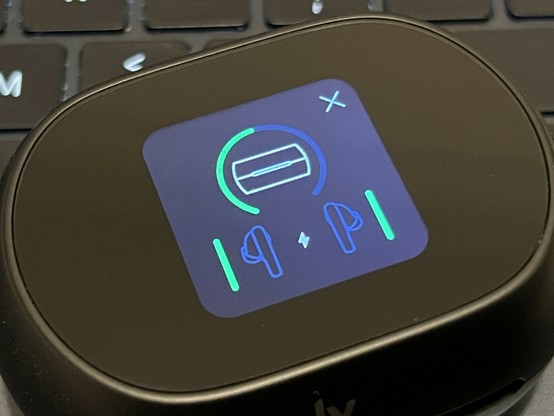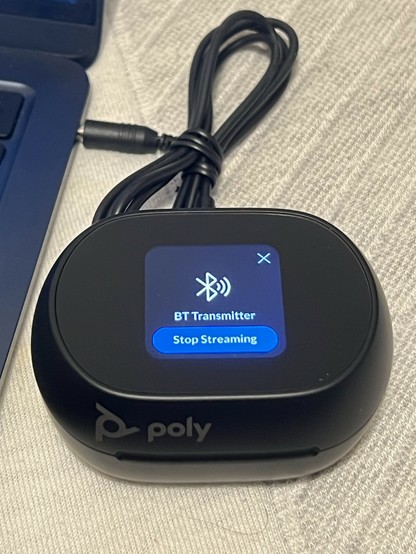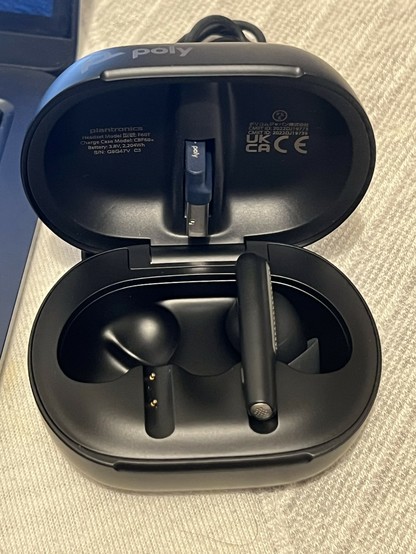Poly Voyager Free 60 Plus Wireless Earphones Reviewed
It’s been a while since I tested anything from Poly, formally known as Plantronics and now part of HP. I tried their Backbeat Pro 2 back in 2018 and compared their microphone quality to the Voyager 8200UC.
What brings me back to Poly is their slightly more off the wall product offerings and a desire to expand my horizons somewhat with my single-sided deafness take on earphone coverage.
Poly have some – not quite unique – but very intriguing earphones in the Voyager Free 60+. They are the first earphones I’ve tested that include a touchscreen LCD display integrated into the case itself. This sounds like a silly gimmick, but actually comes in surprisingly handy for navigating common features that can otherwise require an app to be installed.
They are also the first earphones I’ve tested which allow the case to function as a Bluetooth transmitter, too, setting them aside from much of the competition and, again, actually coming in surprisingly useful.
Poly’s actual earbuds are a little larger than what I’m used to, but they come with very similar comfortable, oval-shaped, silicone tips to those I praised in Jabra’s Elite 10. Let’s see how they stack up-
Build Quality, Look & Feel
I say larger, but it would be fairer to say that Poly’s Voyager Free 60 do more to move bulk around than add it. Like AirPods they have stems that stick out from the main earbud. This allows the bit that fits into your ear to be noticeably smaller than other earbuds I’ve tested, and allows the microphone to be pointed down towards your mouth. Of particular note, also, is how much easier it makes the earbuds to pick up and handle. Smaller is most emphatically not always better, and the Voyager Free 60 – when nestled in their case – are truly excellent at offering a big, easy handle with which to grip one and remove it. In fact the Voyager Free 60 are perhaps the first to pass my “can I remove an earbud from the case and insert it into my ear one-handed” test with flying colours.
While the large stem points upwards when using the right earbud in my left ear ( sometimes the battery runs out in one and I want to use the other instead) it fits surprisingly well and surprisingly comfortably with minimal effort. On close inspection it’s easy to see why this is the case- the main part of Poly’s earbuds are not really shaped to conform with a specific ear and thus fit both ways equally well. Sticky-out-bit notwithstanding.
The Poly Free 60 Plus earbuds. They’re big and have sticky out bits, but this is surprisingly conducive to accessibility. Insofar as earbuds can be accessible. They are easy to grip and remove from their case. Even one-handed.
The set I tested were black, with a uniform matte plastic finish and offset by silver plastic grilles over the main and auxiliary microphones. While the sticky-out-bit look is a little jarring at first compared to fully in-ear buds, the accessibility upsides are nothing to scoff at. Each earbud is very clearly marked with fairly large, bold, L and R in silver silkscreen text, though it’s a little hidden behind the main earbud itself.
The case, for all its merits, is huge and the actual screen area is quite small- occupying roughly 40-50% of the top area. It uses the same style and finish of black plastic as the earbuds themselves, though the screen side of the case is offset with a gloss surface that’s a little prone to picking up fingerprints.
While you might be forgiven for calling these ugly, the large stem and decently sized case make it very easy to remove an earbud. Insofar as earbuds can be accessible, these are quite promising!
Opening the case reveals a rubberised internal top section into which the USB Type-A dongle slots securely. The earbuds sit in a moulded, hard plastic base and use little gold sprung contacts for charging.
Comfort & Fit
The Voyager earbuds have very similar soft, silicone, oval-shaped tips that I praised on Jabra’s Elite 10 earbuds. Unlike harder foam tips these put much less pressure on the inside of my ear and I can – and do – comfortably wear them all day. And night. This comes at a small cost, since silicone tips don’t seal quite as absolutely as ear-plug like foam, so you lose a little on the low-end and passive noise rejection isn’t as good as it could be. It’s worth it for the comfort, though.
What’s missing is any kind of moisture ingress protection rating. I’m sure they’ll hold up to rain, but these are one set of earbuds I will not be subjecting to my typical shower test.
The Case
It’s not unfair to say, for all its features, that the Voyager Free 60 Plus case is big. It is by far the least pocket-friendly case I’ve tested, coming in at almost four times as thick as my iPhone versus an average two or three. This extra bulk gets you internal storage for the supplied USB Type-A Bluetooth adapter. And, of course, the screen.
The case is approximately oval shaped, hinges from the back with the screen in the lid, and has a generous groove in the front to make grasping and opening the case easier. While it may not be easy in all cases, it feels like Poly have made quite a few design choices – intentional or otherwise – to favour accessibility.
The built in LCD will show you a battery gauge for at a glance earphone status. Surprisingly useful and far more granular than a simple coloured LED.
By default the touchscreen on the case is “locked” to prevent the earbud touchscreen equivalent of pocket dialling. Tapping the LCD three times will unlock the case and present you with battery gauges for the case, left and right earbuds.
Closing the battery status – with a little cross in the top right corner – will reveal music transport controls, noise cancelling controls and a second page with Bluetooth pairing controls and transmission controls, audio sources and volume controls.
A third and final screen displays a QR code that links to a “setup voyager free 60” page Poly.com which gets redirected to a generic Poly support page on HP.com. Uh… well it *would* have been useful if someone thought to preserve the URL. This QR code page as a little info icon that takes you to detailed information about the current firmware, earbud firmware, serial number, and an excruciatingly detailed pair of pages of all the information you might normally expect to find printed on the back of a product. There are a couple of references to Plantronics sprinkled in there, too.
Skipping back to the previous pages, the most interesting is the Bluetooth transmission feature. By means of an extremely cursed USB Type-C to 3.5mm audio cable you can connect the Free 60 Plus case to *any* audio device that has one of those vintage 3.5mm jack connectors and use it to bridge that audio output to Bluetooth.
The Poly Free 60+ UC are absolutely wild. They come with a 3.5mm jack to USB Type-C adapter that- when plugged into the charging case - turns it into a Bluetooth transmitter for anything with regular audio out. No pairing needed!
Regrettably this is only a TRS, or “Stereo Audio” jack so you wont get any microphone input, but it’s still very useful for connecting Bluetooth headphones to thinks – I’m looking at you, cheap emulator handhelds – that don’t support them or are otherwise troublesome to set up. It’s a cool feature, and I’ve used it with my Steam Deck to avoid having to juggle which devices the earbuds are paired to. It can be finicky at times, however, requiring audio to play in order to begin and continue streaming. I also find the volume a little hit and miss across devices. Some are a little on the quiet side and others are perfectly fine and no amount of turning the volume up on the earbuds or device itself will help. A little fiddling about on the case LCD menu, however, and suddenly the volume will decide it’s actually at 50% and let me crank it up. After much puzzling about this, I realised that the transport controls (the note icon on the main screen) become a *second volume control* in Bluetooth Streaming mode and you need to use those controls instead of the normal volume. Weird, but… sure, fine.
The App
The accompanying app, Poly Lens, is relatively on a par with others I’ve tested, and exposes a comprehensive set of options for customising the earbuds. What’s notably missing is any kind of app “Dashboard”, while you’ll see a picture of the connected device and some battery/connection status there’s no shortcut to control ANC settings, no quick EQ presets and no fancy audio soundscapes. This is somewhat forgivable since most of these controls are on the case itself, but using the LCD does impact battery life – not to mention your phone might be more to hand than the case itself – so it’s unfortunate.
The usual assortment of sensor settings are present, and you can disable the wear sensors, auto call answering and so on if those features don’t work well for you.
What’s crucially missing is any means to re-bind the physical buttons on the earbuds. What’s fortunate for us single-sided deafness users, however, is that the button actions are the same between the left and right earbud- a single press to answer/end a call or play/pause media depending upon context, a double press (at least for me?) triggered “Redailing last number”, a long press (four seconds) for Bluetooth pairing, or (two seconds) Siri/Google Assistant. That’s a lot of features overloaded on a single button and I’d love to be able to configure my normal ANC on/off and Audio Play/Pause setup, but at least – in stark contrast to other earbuds I’ve tested- these button binds are the same for both buds making it easier to use one or the other.
The earbuds can also have a swipe gesture, but I find these a little tricky to activate and much prefer the physical buttons. You can bind the swipe gesture to multiple different actions across different contexts – Idle, In Call, Streaming Media – and – again – the swipe bind is the same on both earbuds making them easy to swap between. What you can bind depends on the context, but “Do nothing” is, thankfully, an option in all cases if you want to avoid any mishaps on calls.
Single-sided Accessibility
I can’t really count the lack of control rebinding against Poly here, the symmetry of controls and symmetry of design means that either earbud works in either ear with no problems or discomfort whatsoever. Yes having the sticky-out-bit (I should probably just call it a stem) pointing upwards probably looks a little awkward, but wearing the right earbud in my left ear doesn’t feel any meaningfully different from wearing the left in my left ear. So while the Voyager Free 60 Plus aren’t quite as ear-agnostic as I imagine bullet-shaped earbuds to be, they are definitely the most accessible – both in terms of single-sided deafness, and ease of grasping – earbuds that I’ve tested thus far.
Yes, the swipe gesture will probably be quite awkward in the wrong ear, but you can turn it completely off in all contexts to avoid mishaps. The little button on the end of the stem is somehow just as easy to press whether it’s in the wrong or right ear.
Overall
By accident of their design, the Voyager Free 60 Plus’s weakness is sleep comfort. The large stem means they are not comfortable to sleep on if you’re a side-sleeper. That said, I’ve fallen asleep listening to them on multiple occasions and the lack of large, awkwardly placed buttons or full touch functionality means I have- at least- not accidentally turned them off or paused my music while trying to get comfortable.
The case size could be seen as a weakness or a strength depending on your propensity to lose things in the bottom of a bag. The case is not super jeans-pocket friendly, though I have carried it in my pocket anyway. The large case, large lid, and large groove for opening could easily be seen as a boon to accessibility. If you have hand or finger mobility problems that aren’t quite severe enough to discount earbuds altogether, these might be some of the easiest – or less bad – to work with. Similarly if you’re prone to retrieving and fitting an earbud one-handed for whatever reason, the large, grippable stem make them very easy to whip out of the box.
The Voyager Free 60 are close, conceptually, to Jabra’s Elite2 Buds which I’m currently also testing. While on paper they have pretty much the same RRP, but Jabra’s buds are currently cheaper. They lack that easy graspability, strong ear agnosticism and – actually quite cool – LCD touchscreen though.
The sticky-out stem isn’t super in vogue unless it’s white and Apple-branded, and I’m not afraid to say that these form-follows-function earbuds are not what I would consider super stylish. As someone who should probably be wearing a hearing aid, I’m particularly cognisant of using things that might draw attention to my ears. I think I’m overthinking it, though, since I have worn these earbuds out in public (or one of them, anyway) without the raucous laughter or mockery that some small part of me expects. I fully understand how silly I’m being here. The Voyager Free 60 are excellent, and only get more so if you need or want an earbud you can stick upside-down in the wrong ear without discomfort.




